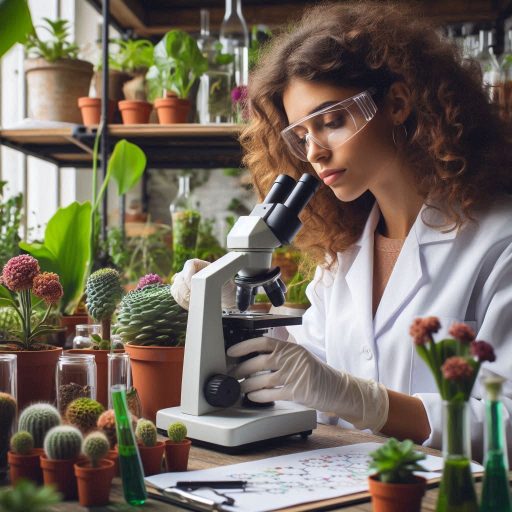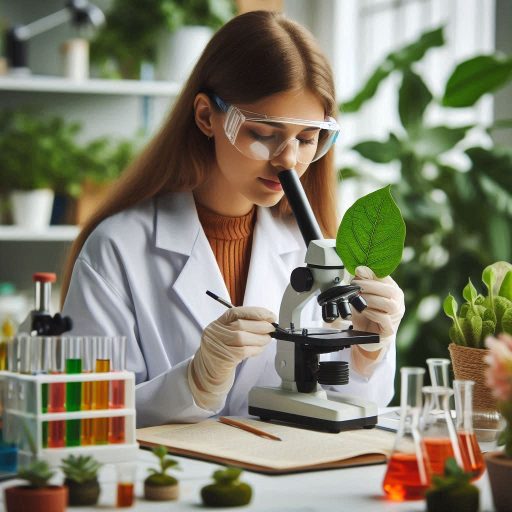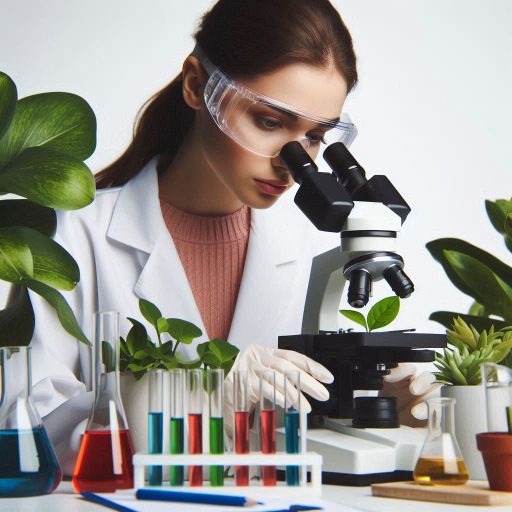Introduction
Plant scientists play a crucial role in environmental conservation and sustainability.
They study plant biology to understand how plants interact with their environments.
Through their research, they develop strategies to enhance biodiversity, restore ecosystems, and mitigate climate change.
Plants are essential to our ecosystem.
They produce oxygen, sequester carbon dioxide, and provide food and habitat for countless species.
Healthy plant communities support soil health and prevent erosion, maintaining the balance of ecosystems.
Additionally, plants help regulate water cycles and improve air quality.
Plant scientists work on various projects aimed at preserving and restoring plant life.
They study native plant species to promote biodiversity and develop conservation plans.
These scientists also explore sustainable agricultural practices that reduce chemical use and minimize environmental impact.
Moreover, they engage in reforestation efforts to restore degraded lands and combat climate change.
By understanding plant genetics, they can develop resilient varieties that thrive in changing climates.
In this blog post, we will delve deeper into the specific ways plant scientists contribute to environmental health.
We will explore their research initiatives and the positive impacts they have on ecosystems.
Their work is vital for ensuring a sustainable future for our planet and its inhabitants.
Research and Development
Conducting Research to Improve Plant Species
Plant scientists conduct extensive research to improve plant species and support environmental health.
They study various aspects of plant biology, including genetics, physiology, and ecology.
This research aims to enhance the productivity and resilience of plant species.
One primary focus is understanding how plants respond to environmental stresses.
Plant scientists investigate how factors like drought, temperature, and soil quality affect growth.
By analyzing these responses, they identify traits that enable plants to thrive in challenging conditions.
Field trials play a crucial role in this research.
Plant scientists test different plant varieties under controlled conditions.
They gather data on growth rates, yields, and stress responses.
This hands-on approach allows them to make informed decisions about which traits to prioritize in breeding programs.
Moreover, plant scientists collaborate with ecologists and environmental scientists.
This collaboration helps them understand how plants interact with their ecosystems.
By examining these relationships, they can develop practices that promote biodiversity and ecosystem health.
Developing New Plant Varieties for Disease and Pest Resistance
Another vital contribution of plant scientists is developing new plant varieties that resist diseases and pests.
Plant diseases and pests pose significant threats to food production and environmental stability.
By creating resilient varieties, scientists help ensure food security while minimizing chemical use.
Plant scientists utilize various techniques to breed resistant varieties.
Traditional breeding involves cross-pollinating plants with desirable traits.
This method allows them to create new hybrids with improved resistance to specific diseases or pests.
Biotechnology also plays a significant role in developing resistant plant varieties.
Scientists use genetic engineering techniques to introduce specific genes associated with resistance.
This approach can produce crops that withstand diseases or pests more effectively than traditional varieties.
For example, researchers have developed genetically modified crops that resist certain insect pests.
These crops reduce the need for chemical pesticides, benefiting both the environment and human health.
By minimizing pesticide use, plant scientists promote sustainable agricultural practices.
Additionally, plant scientists study the genetic diversity of wild relatives of cultivated crops.
These wild species often possess traits that confer resistance to diseases and pests.
By incorporating these traits into cultivated varieties, scientists can enhance resilience and adaptability.
Importance of Collaborative Efforts
Collaboration among plant scientists, farmers, and policymakers is essential.
Plant scientists work closely with agricultural stakeholders to implement research findings in practical settings.
This partnership ensures that new varieties meet the needs of farmers and consumers.
Furthermore, educating farmers about resistant varieties and sustainable practices is crucial.
Plant scientists often conduct workshops and training sessions to share knowledge.
By empowering farmers with information, they can adopt practices that protect both their crops and the environment.
Plant scientists play a vital role in helping the environment through their research.
They focus on improving plant species and developing new varieties resistant to diseases and pests.
Their efforts contribute to sustainable agriculture and biodiversity conservation.
By collaborating with various stakeholders, plant scientists enhance food security while promoting environmental health.
Their work addresses critical challenges posed by climate change and ecosystem degradation, ensuring a more sustainable future for our planet.
Read: Challenges and Rewards: The Dual Life of an U.S. Environmental Scientist
Climate Change Mitigation
Developing Carbon-Dioxide-Absorbing Plants
Plant scientists play a crucial role in combating climate change.
They focus on developing plants that can absorb more carbon dioxide.
Through selective breeding and genetic engineering, scientists create plant varieties with enhanced carbon uptake capabilities.
These innovative plants increase photosynthesis efficiency.
They can convert more carbon dioxide into oxygen, thereby reducing greenhouse gas levels.
For instance, scientists study species like bamboo, which naturally absorb large amounts of carbon dioxide.
By optimizing such plants, researchers aim to enhance their carbon-sequestering potential.
Furthermore, scientists explore the relationship between plant root systems and carbon storage.
Deeper roots allow plants to sequester more carbon underground.
This process prevents carbon from re-entering the atmosphere, promoting long-term carbon storage.
Scientists analyze how different soil types and plant species affect root growth, leading to better carbon storage strategies.
Reducing Greenhouse Gas Emissions
Certain plants also help reduce greenhouse gas emissions through various mechanisms.
For example, some plants can absorb and store methane, a potent greenhouse gas.
Researchers study specific species that excel in methane absorption, contributing to lower overall emissions.
Wetland plants, such as reeds and cattails, play a significant role in this process.
They can absorb methane released from decomposing organic matter.
By enhancing wetland restoration efforts, plant scientists can promote the growth of these beneficial species.
Additionally, plant scientists examine how plants can improve soil health, which directly impacts greenhouse gas emissions.
Healthy soils contain more organic matter, enhancing carbon storage and reducing nitrous oxide emissions.
Plant scientists develop strategies to improve soil quality through crop rotation and cover cropping.
Contributions to Sustainable Agriculture
Plant scientists contribute to sustainable agriculture practices that support environmental health.
By developing crops that require fewer chemical fertilizers, scientists help reduce nitrogen runoff.
Excess nitrogen can contribute to greenhouse gas emissions and water pollution.
Scientists also focus on creating drought-resistant plant varieties.
These plants require less water, reducing the need for irrigation.
Less irrigation helps minimize water-related greenhouse gas emissions, such as methane released from flooded fields.
Furthermore, plant scientists work on developing integrated pest management (IPM) strategies.
IPM uses biological control and resistant plant varieties to minimize pesticide use.
Reducing pesticide application lowers the environmental impact and enhances biodiversity.
In essence, plant scientists play a vital role in helping the environment.
They develop plants that can absorb more carbon dioxide, significantly contributing to climate change mitigation.
These advancements in plant science enhance photosynthesis and promote deeper root systems for carbon storage.
Moreover, certain plants help reduce greenhouse gas emissions through mechanisms like methane absorption.
Plant scientists‘ research leads to improved soil health and sustainable agriculture practices that benefit the environment.
By focusing on innovative plant development and management strategies, plant scientists can create a greener and more sustainable future.
Their efforts not only address current environmental challenges but also pave the way for long-term solutions.
Through their dedication and expertise, plant scientists work towards a healthier planet for future generations.
Read: Job Market Trends: Future of Chemistry Jobs in America
Conservation Efforts
Preserving Endangered Plant Species
One of the primary responsibilities of plant scientists is preserving endangered plant species.
They conduct research to understand the factors leading to plant extinction.
This knowledge allows them to develop effective conservation strategies.
Plant scientists often collaborate with conservation organizations and governmental agencies.
Together, they identify priority species and areas for protection.
They assess the current population status of endangered plants.
This assessment guides conservation efforts and resource allocation.
Seed banks serve as crucial tools in preserving genetic diversity.
Plant scientists collect and store seeds from endangered species for future use.
These seed banks help safeguard plants against extinction due to habitat loss or climate change.
They also provide valuable genetic material for research and restoration projects.
Additionally, plant scientists engage in public education efforts.
They raise awareness about the importance of preserving endangered plants.
Through workshops and outreach programs, they inform communities about conservation initiatives.
Increased public support enhances conservation success.
Restoring Habitats for Native Plant Species
In addition to preserving endangered species, plant scientists work to restore habitats for native plants.
Habitat loss poses a significant threat to plant biodiversity.
Plant scientists develop and implement restoration plans to revive these vital ecosystems.
They begin by assessing degraded habitats and identifying restoration needs.
This assessment often involves soil analysis, water availability, and existing plant communities.
Based on this data, scientists develop tailored restoration strategies.
Plant scientists often utilize native plant species in their restoration efforts.
Using local plants promotes biodiversity and ecosystem resilience.
Native species are better adapted to local conditions and support native wildlife.
Collaboration is essential for successful habitat restoration.
Plant scientists frequently work with local communities, NGOs, and government agencies.
Together, they plan and execute restoration projects that benefit both plants and people.
Monitoring the success of restoration efforts is crucial.
Plant scientists evaluate the growth and health of restored habitats over time.
They use data to refine methods and improve future restoration projects.
In sum, plant scientists play an essential role in helping the environment.
Their work in preserving endangered plant species is critical for maintaining biodiversity.
By establishing seed banks and engaging in public education, they foster greater awareness of conservation efforts.
Additionally, plant scientists actively restore habitats for native species, promoting ecological resilience.
Through collaboration and research, these scientists contribute to a healthier planet for future generations.
Their dedication to environmental stewardship highlights the importance of plant science in addressing global challenges.
Read: Challenges and Rewards: Navigating the Chemist Career Path

Sustainable Agriculture
Promoting Sustainable Farming Practices
Plant scientists play a vital role in promoting sustainable farming practices.
They research methods that reduce environmental impact while increasing productivity.
By advocating for sustainable techniques, they help farmers adopt practices that conserve resources.
One key area of focus is integrated pest management (IPM).
IPM combines biological control, habitat manipulation, and resistant varieties to manage pests.
This approach reduces the reliance on chemical pesticides, leading to healthier ecosystems.
Plant scientists also emphasize crop rotation and cover cropping.
These practices improve soil health and reduce erosion.
By rotating crops, farmers can break pest and disease cycles, enhancing overall farm resilience.
Additionally, they work on educating farmers about sustainable practices.
Workshops, seminars, and extension programs provide farmers with the knowledge needed for effective implementation.
This outreach ensures that sustainable practices are accessible and practical for all farmers.
Developing Water- and Fertilizer-Efficient Crop Varieties
In their quest to support sustainability, plant scientists develop crop varieties that require less water and fertilizer.
Drought-resistant crops are essential for addressing water scarcity issues.
These varieties thrive in arid conditions, ensuring food security in challenging climates.
Through genetic engineering and selective breeding, scientists create crops with enhanced drought tolerance.
These innovations help farmers maintain yields during periods of water scarcity.
As a result, they reduce the need for irrigation, conserving precious water resources.
Moreover, plant scientists focus on improving nutrient use efficiency in crops.
They develop varieties that can thrive on lower fertilizer inputs.
By maximizing nutrient uptake, these crops minimize the environmental impact of agricultural practices.
Research on nitrogen-fixing crops also plays a crucial role.
These plants, such as legumes, can naturally enrich the soil with nitrogen.
By incorporating these crops into rotations, farmers can reduce their dependence on synthetic fertilizers.
Impact on Soil Health and Ecosystems
The work of plant scientists directly impacts soil health and ecosystems.
Sustainable practices enhance soil structure and fertility.
Healthier soils lead to better water retention and improved crop resilience.
Moreover, by reducing chemical inputs, plant scientists help protect biodiversity.
Lower pesticide and fertilizer use minimizes harmful runoff into water bodies.
This protection benefits aquatic ecosystems and promotes overall environmental health.
Plant scientists also contribute to habitat restoration efforts.
They study native plant species and their roles in ecosystems.
By promoting the use of native plants in restoration projects, they enhance local biodiversity.
In general, plant scientists significantly help the environment through their work.
They promote sustainable farming practices that reduce environmental impact and enhance productivity.
By developing crop varieties that require less water and fertilizer, they address critical challenges in agriculture.
Their research and outreach efforts empower farmers to adopt practices that protect the environment.
As the global population grows, the contributions of plant scientists become increasingly vital for achieving food security and sustainability.
Their work ensures a healthier planet for future generations.
Read: Diverse Career Paths: From Chemist to Patent Attorney in the US
Biofuel Development
The Role of Plant Scientists in Biofuel Research
Plant scientists investigate various plant species to identify those most suitable for biofuel production.
They study the growth conditions, yield potential, and energy content of these plants.
Common candidates include corn, sugarcane, and switchgrass, known for their high biomass.
Through genetic research, plant scientists can enhance the traits of biofuel crops.
They develop varieties with higher oil or sugar content, increasing overall efficiency.
This work leads to more effective biofuel production methods that utilize less land and water.
Moreover, plant scientists explore alternative biofuel sources, such as algae.
Algae can produce significant amounts of oil and grow in various environments.
Researchers analyze the best conditions for maximizing oil production from algae, further diversifying biofuel options.
In addition to developing biofuels, plant scientists conduct lifecycle assessments.
These assessments evaluate the environmental impact of biofuel production from cultivation to combustion.
Understanding these impacts helps identify areas for improvement and ensures sustainable practices.
Reducing Dependence on Fossil Fuels
Biofuels offer a renewable alternative to fossil fuels, which are finite resources.
By using plant-based materials, we can create energy sources that are sustainable and abundant.
This transition helps reduce our dependence on traditional fossil fuels, such as oil and coal.
Using biofuels can significantly lower carbon emissions.
When plants grow, they absorb carbon dioxide from the atmosphere.
This process helps offset the carbon released during the combustion of biofuels.
Therefore, switching to biofuels can help mitigate climate change and improve air quality.
Additionally, biofuels contribute to energy security.
They reduce reliance on imported fossil fuels, promoting local energy production.
This shift supports local economies and creates jobs in agriculture and biofuel production sectors.
Lowering Carbon Emissions
Biofuels have the potential to lower greenhouse gas emissions compared to conventional fossil fuels.
Studies show that biofuels can reduce emissions by up to 80%.
This significant reduction plays a crucial role in combating global warming.
Plant scientists also work on improving the efficiency of biofuel production processes.
They develop technologies that convert biomass into fuel more effectively.
These advancements minimize energy waste and reduce the overall carbon footprint of biofuel production.
Moreover, integrating biofuels into existing energy systems requires collaboration among scientists, policymakers, and industries.
Plant scientists provide valuable insights that inform policies supporting biofuel development.
By fostering partnerships, they help create a sustainable energy future.
In closing, plant scientists are instrumental in researching and developing biofuels from plants.
Their work helps reduce dependence on fossil fuels and lower carbon emissions.
Through innovative research and sustainable practices, they contribute to a healthier planet.
As the demand for renewable energy sources grows, the role of plant scientists will become increasingly vital.
Their efforts will continue to shape a sustainable future for generations to come.
You Might Also Like: The Importance of Meteorology in Agriculture and Aviation
Transform Your Career Today
Unlock a personalized career strategy that drives real results. Get tailored advice and a roadmap designed just for you.
Start NowUrban Greening
Designing Green Spaces in Urban Areas
Plant scientists work on designing green spaces to enhance urban environments.
They analyze local ecosystems and choose appropriate plant species.
Selecting native plants promotes biodiversity and supports local wildlife.
Incorporating green spaces into city planning is essential.
Plant scientists collaborate with urban planners and architects to create sustainable designs.
They consider factors like sunlight, soil quality, and water availability in their plans.
These green spaces can take many forms.
Plant scientists design parks, rooftop gardens, and community gardens.
Each of these spaces provides unique benefits to urban dwellers.
Moreover, plant scientists implement strategies for maintaining these green areas.
They create guidelines for plant care, irrigation, and pest management.
These practices ensure the longevity and health of urban green spaces.
Benefits of Urban Greening
Urban greening offers numerous environmental benefits.
One major advantage is its ability to mitigate air pollution.
Plants naturally filter pollutants from the air, improving air quality for city residents.
Trees and plants absorb carbon dioxide and release oxygen.
This process helps reduce greenhouse gases in urban environments.
By increasing the number of green spaces, plant scientists contribute to cleaner air and a healthier atmosphere.
Urban greening also addresses the heat island effect.
Urban areas often experience higher temperatures due to concrete and asphalt surfaces.
This phenomenon can lead to increased energy consumption and health risks.
Plant scientists help counteract this effect by increasing vegetation in cities.
Plants provide shade and release moisture into the air, cooling their surroundings.
As a result, urban greening can significantly lower local temperatures.
Additionally, green spaces can enhance residents’ quality of life.
They provide recreational opportunities and promote mental well-being.
Studies show that access to nature improves overall health and happiness.
Long-Term Environmental Impact
The long-term environmental impact of urban greening is profound.
Plant scientists contribute to creating resilient cities that can withstand climate change.
Greener urban areas are better equipped to handle extreme weather events, such as heavy rain or heat waves.
By improving biodiversity, green spaces foster ecosystems that support various species.
This diversity enhances the overall resilience of urban environments.
It creates habitats for birds, insects, and other wildlife.
Furthermore, urban greening initiatives often engage local communities.
Plant scientists collaborate with residents to plant trees and maintain gardens.
This involvement fosters a sense of community and responsibility for local environments.
Generally, plant scientists significantly contribute to environmental sustainability through their work in urban greening.
They design and implement green spaces that improve air quality and reduce heat island effects.
The benefits of these initiatives extend beyond environmental health, enhancing residents’ quality of life.
As cities continue to grow, the role of plant scientists in creating greener, more sustainable urban areas becomes increasingly vital.
Their expertise helps build resilient communities that thrive in harmony with nature.
Education and Outreach
The Importance of Plant Scientists in Education
Plant scientists play a crucial role in educating the public about the importance of plants.
They highlight how plants contribute to our ecosystem and human survival.
Through their expertise, they explain the vital functions of plants, such as oxygen production and carbon dioxide absorption.
Education initiatives often include workshops, community programs, and school presentations.
Plant scientists engage with diverse audiences, making complex scientific concepts accessible.
Their efforts raise awareness about the critical role plants play in maintaining biodiversity and ecological balance.
By informing the public, plant scientists help foster a greater appreciation for the natural world.
They encourage individuals to recognize the value of local flora and fauna.
This understanding can inspire conservation efforts and promote sustainable practices in everyday life.
Promoting Environmental Awareness and Advocating for Conservation Efforts
Plant scientists actively promote environmental awareness through research and outreach.
They study how environmental changes, such as climate change, impact plant life.
Their findings provide essential data to inform public policy and conservation strategies.
Additionally, plant scientists contribute to the development of educational materials and resources.
They create informative content, including articles, videos, and interactive presentations.
These resources help the public understand plant-related issues, such as habitat destruction and invasive species.
Collaborating with schools and community organizations, plant scientists lead initiatives to plant trees and restore native habitats.
These hands-on activities allow individuals to connect with their environment.
Participants gain a deeper understanding of the significance of plants in their local ecosystems.
Plant scientists advocate for conservation efforts on multiple fronts.
They collaborate with governmental and non-governmental organizations to address environmental challenges.
Their expertise guides policies aimed at protecting endangered plant species and preserving natural habitats.
By conducting research on plant species and ecosystems, they identify areas needing conservation.
Their work informs land management practices and restoration projects.
This proactive approach ensures that ecosystems remain resilient in the face of human impact.
Plant scientists also study the effects of climate change on plant species.
They develop strategies to mitigate these effects, promoting plant resilience and adaptability.
This research is crucial for maintaining biodiversity and ensuring ecosystem health.
Building Community Engagement
Community engagement is a vital aspect of the work done by plant scientists.
They involve local communities in conservation projects, fostering a sense of ownership.
Engaging the public in planting and caring for native plants helps create lasting connections with nature.
Plant scientists often organize events such as tree-planting days and garden workshops.
These activities encourage community members to take an active role in environmental stewardship.
Through these initiatives, they build a network of advocates for plant conservation.
Moreover, plant scientists leverage social media and online platforms to reach broader audiences.
They share research findings, conservation tips, and plant care advice.
This digital outreach extends their impact and encourages environmental advocacy.
When all is said and done, plant scientists significantly contribute to environmental education and conservation efforts.
They educate the public about the importance of plants and promote awareness of environmental issues.
Their advocacy for conservation and community engagement fosters a deeper appreciation for the natural world.
By highlighting the critical role of plants, they inspire individuals to take action for a sustainable future.
Find Out More: Online Courses for Epidemiology: Best Platforms
Conclusion
Plant scientists play a crucial role in protecting and preserving the environment.
They conduct research to understand plant ecosystems and their functions.
By studying plant interactions with other organisms, they contribute valuable insights into biodiversity and ecosystem health.
One significant area of focus is the development of sustainable agricultural practices.
Plant scientists work to create crop varieties that require fewer resources and reduce environmental impact.
Their efforts help minimize the use of pesticides and fertilizers, which can harm ecosystems.
Plant scientists also address climate change challenges by researching plants’ responses to changing environmental conditions.
They explore how different species adapt to climate shifts, contributing to strategies for conservation and restoration.
This research aids in selecting resilient plants for reforestation and habitat restoration projects.
Furthermore, plant scientists educate communities about the importance of native plants and biodiversity.
They promote sustainable land management practices that protect natural habitats and support local wildlife.
Plant scientists are vital in safeguarding the environment.
Their research and advocacy contribute to sustainable practices, biodiversity preservation, and climate resilience.
By understanding and protecting plant life, they help create a healthier planet for future generations.
Supporting their work is essential for achieving environmental sustainability and resilience.
[E-Books for Sale]
The Big Book of 500 High-Paying Jobs in America: Unlock Your Earning Potential
$19.99 • 500 High-Paying Jobs • 330 pages
Explore 500 high-paying jobs in America and learn how to boost your career, earn more, and achieve success!
See All 500 High-Paying Jobs of this E-Book
1001 Professions Without a Degree: High-Paying American Jobs You Can Start Now
$19.99 • 1001 Professions Without a Degree • 174 pages
Discover 1001 high-paying jobs without a degree! Unlock career tips, skills, and success strategies for just $19.99!




